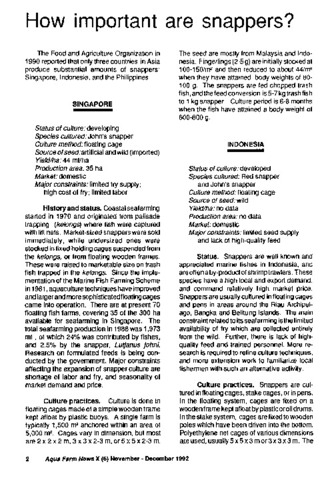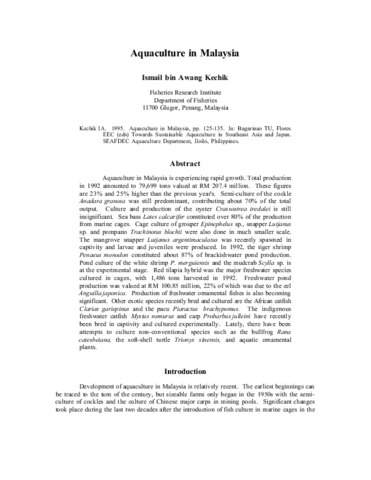Maturation and induced spawning of the mangrove red snapper (Lutjanus argentimaculatus) reared in a floating net cage in the Philippines
- Global styles
- MLA
- Vancouver
- Elsevier - Harvard
- APA
- Help
View/
Date
1996Author
Page views
3,783AGROVOC keyword
Taxonomic term
Metadata
Show full item record
Share
Abstract
Wild-caught mangrove red snapper (Lutjanus argentimaculatus) were reared in a floating net cage at SEAFDEC/AQD's Igang Marine Substation at Guimaras Island, Central Philippines. In 1993, monthly samplings and induced spawning trials were conducted as part of a project on seed production. Gonadal development began in February for males and April for females, reached a peak in September and declined in December. Males and females had ripe gonads for up to 5-6 consecutive months. Spawning occurred in the evening (2000 to 2300 hours), 32-36 hours after a single intramuscular injection of 1,500 IU human chorionic gonadotropin kg-1 body weight (BW). About 0.53-2.14 million eggs were collected per female (2.5-4.4 kg BW) with fertilization rates of 21-97% and hatching rates of 42-80% resulting in 30-85% normal larvae (straight and without deformities). The results strongly suggest the feasibility of breeding mangrove red snapper in floating net cages.
Suggested Citation
Emata, A. C. (1996). Maturation and induced spawning of the mangrove red snapper (Lutjanus argentimaculatus) reared in a floating net cage in the Philippines. In F. Arrenguin-Sanchez, J. L. Munro, M. C. Balgos, & D. Pauly (Eds.), Biology, Fisheries and Culture of Tropical Groupers and Snappers (pp. 378–384). Makati City, Philippines: International Center for Living Aquatic Resources Management.
Type
Conference paperISSN
0115-4435ISBN
9718709622Collections
- Conference Proceedings [299]
Related items
Showing items related by title, author, creator and subject.
-
How important are snappers?
Castaños, Milagros T.; Southeast Asian Fisheries Development Center, Aquaculture Department (Aquaculture Department, Southeast Asian Fisheries Development Center, 1992) -
Aquaculture in Malaysia
Kechik, Ismail bin Awang. (Aquaculture Department, Southeast Asian Fisheries Development Center, 1995)Aquaculture in Malaysia is experiencing rapid growth. Total production in 1992 amounted to 79,699 tons valued at RM 207.4 million. These figures are 23% and 25% higher than the previous year's. Semi-culture of the cockle ... -
Culture of grouper, sea bass and red snapper
Toledo, Joebert D. (University of the Philippines Aquaculture Society, Inc., 2001)Marine fish production has increased dramatically in the past ten years and majority of the cultured species were produced in Asia in 1992. Increase in production was accompanied with concerns on increasing outbreak of ...





